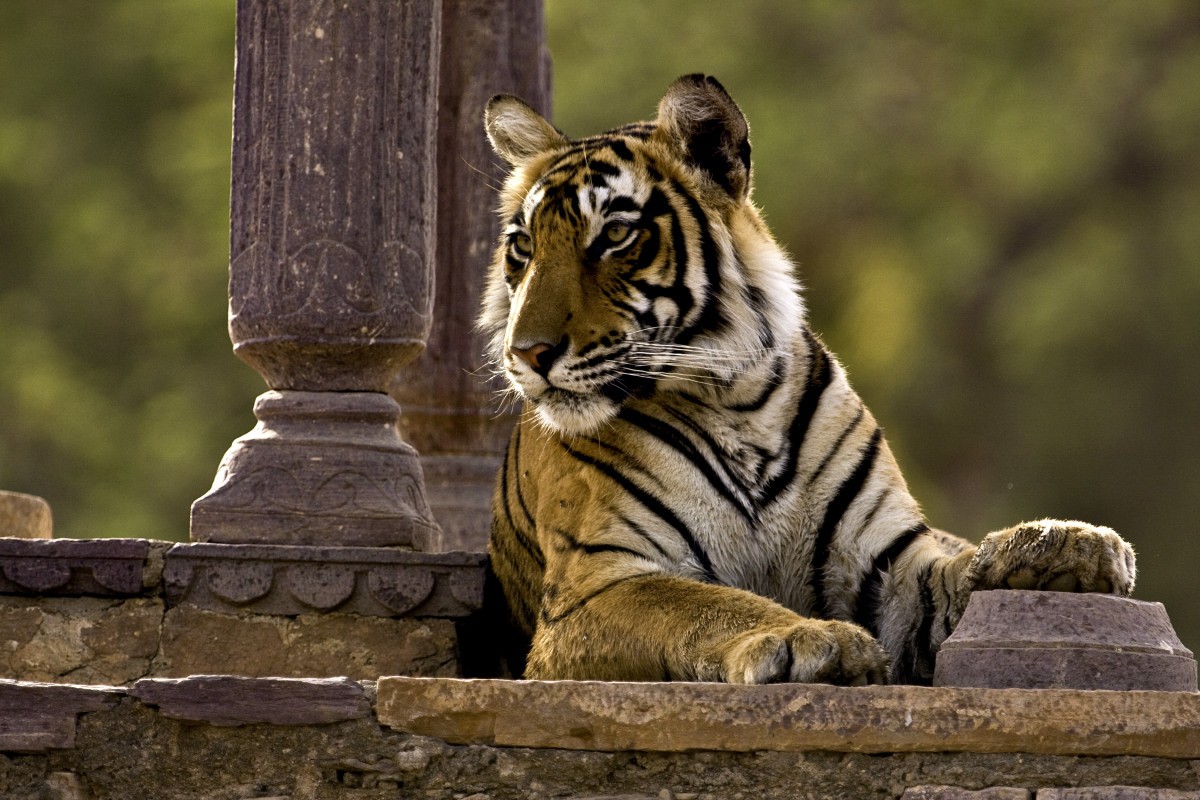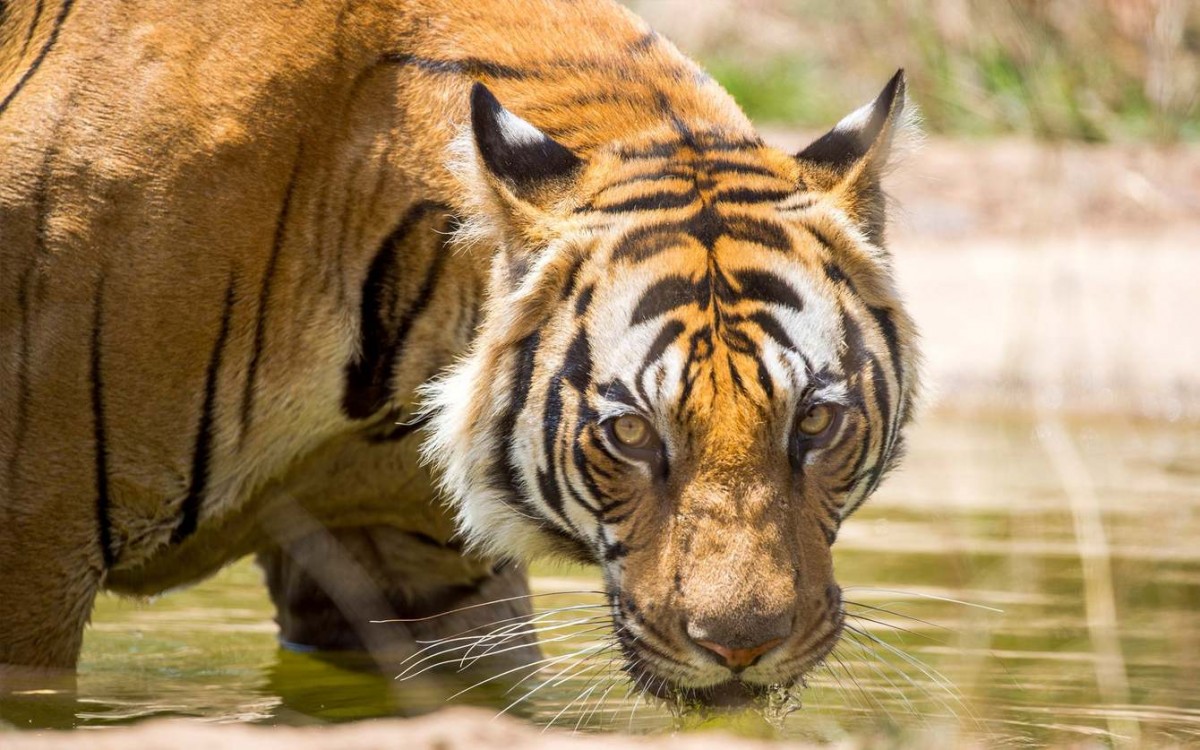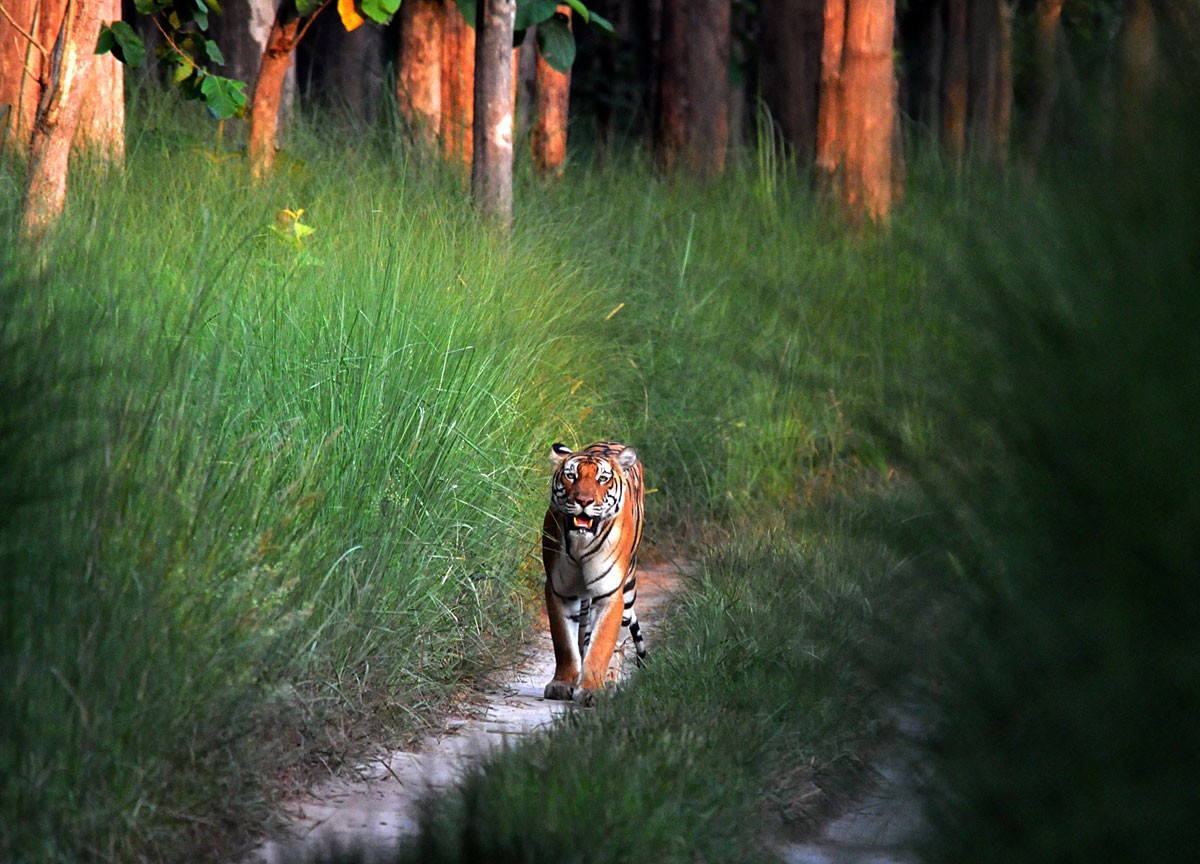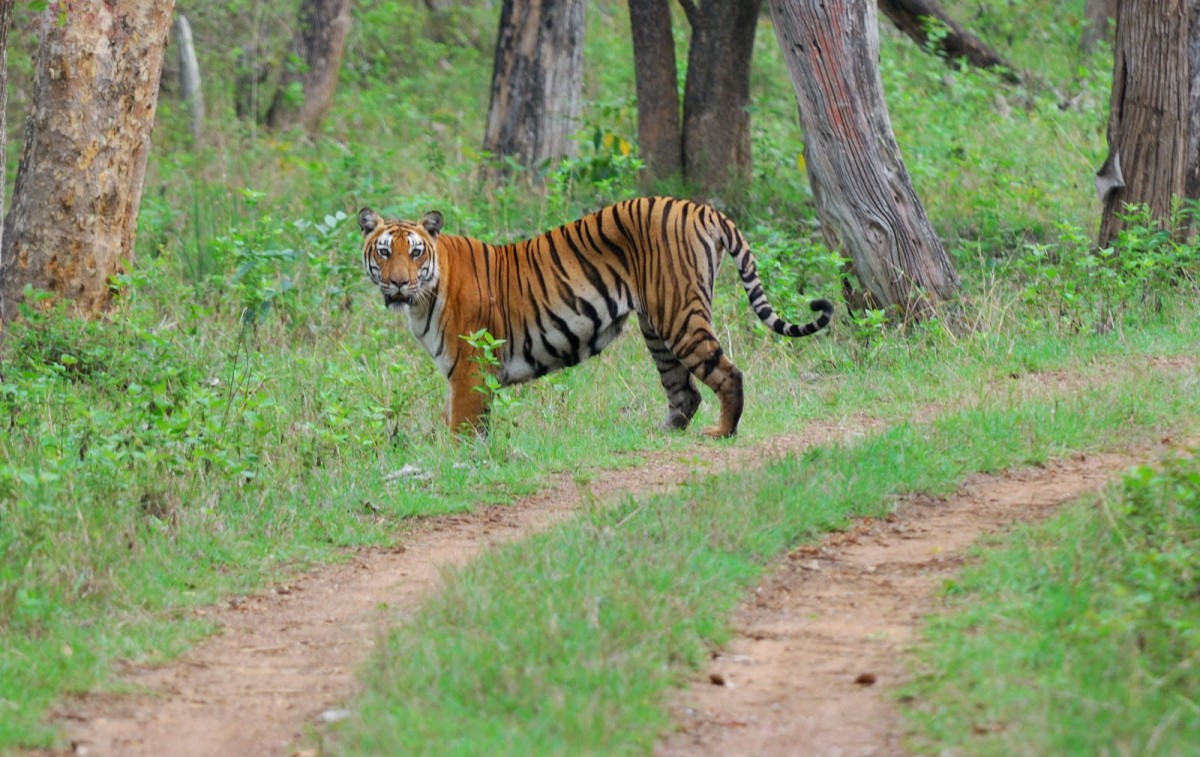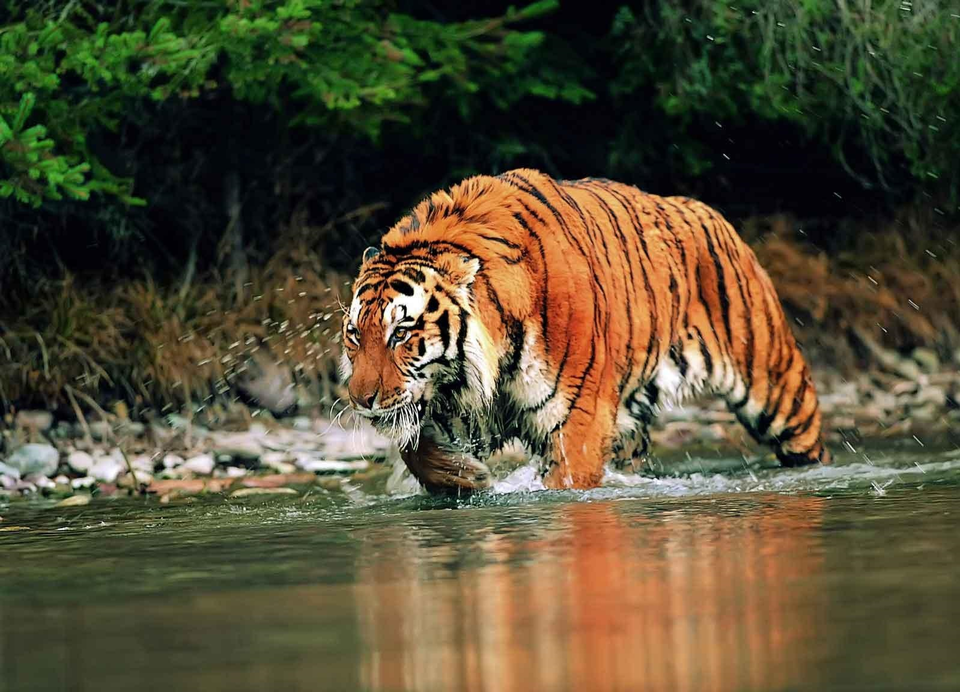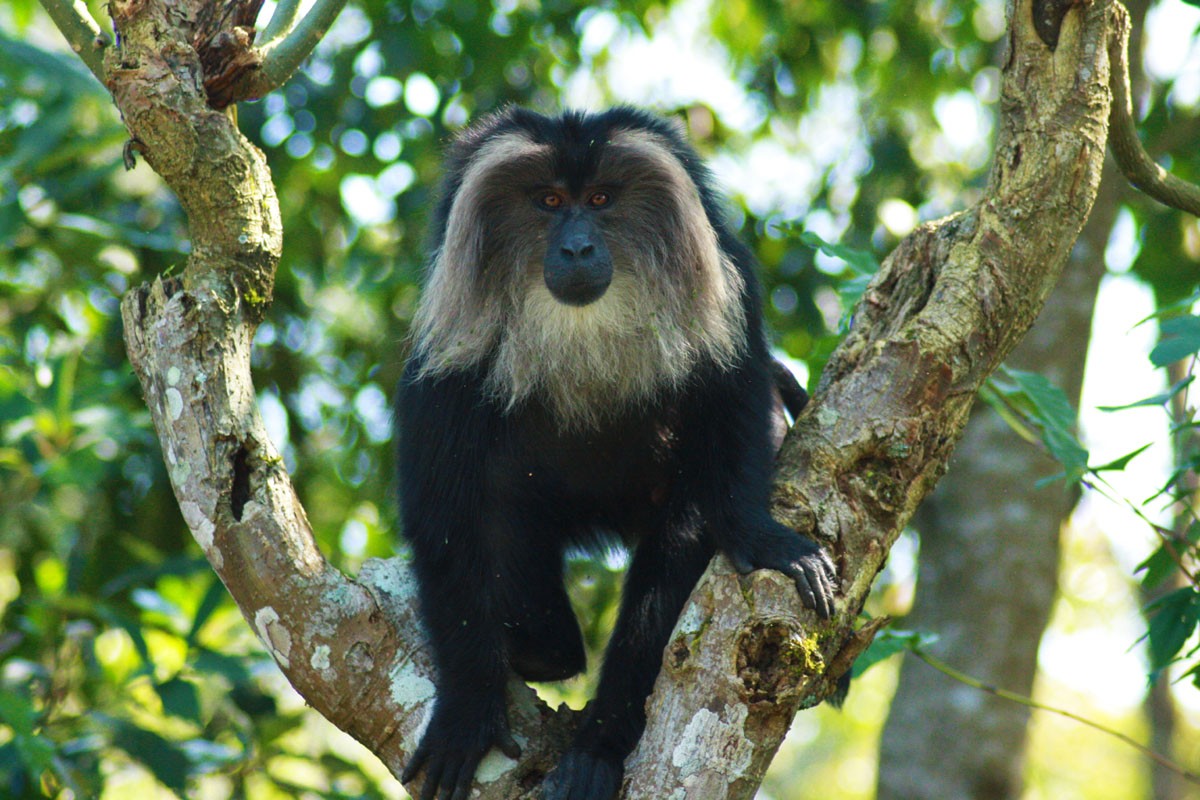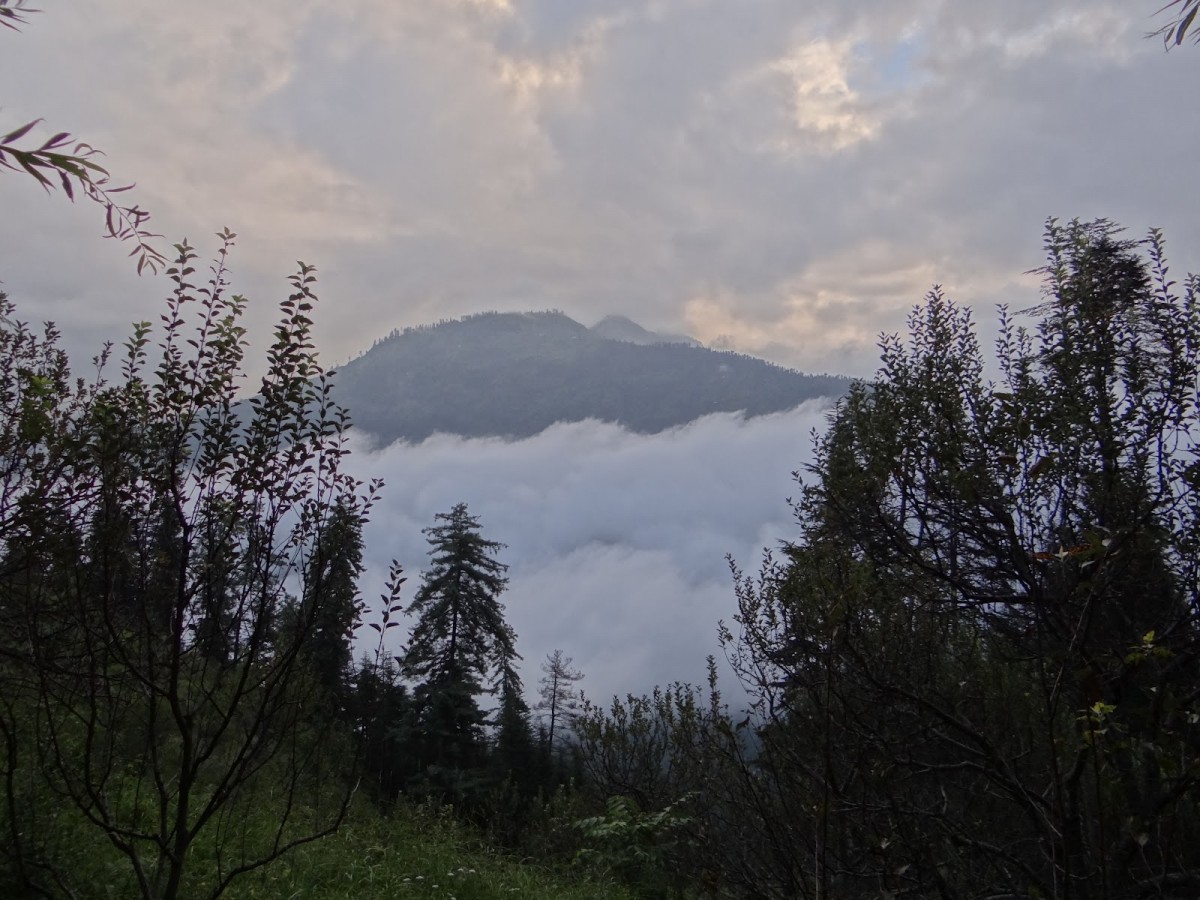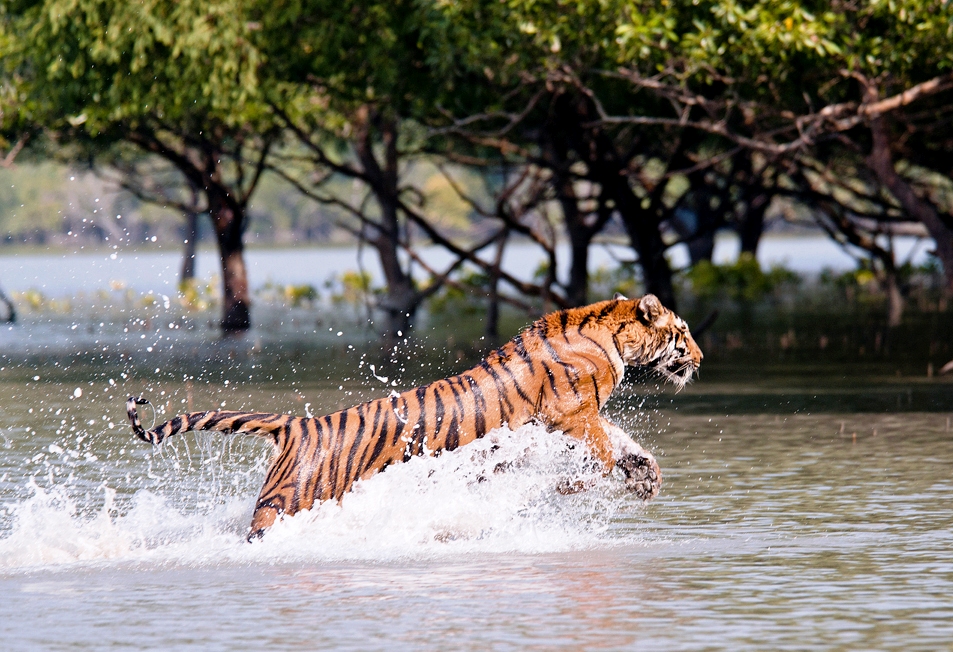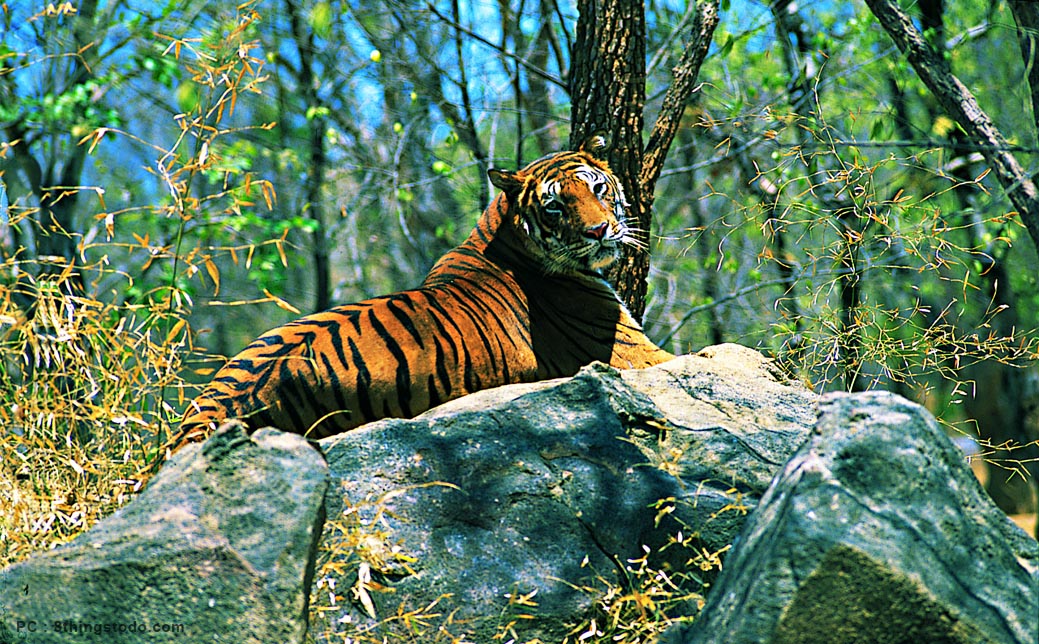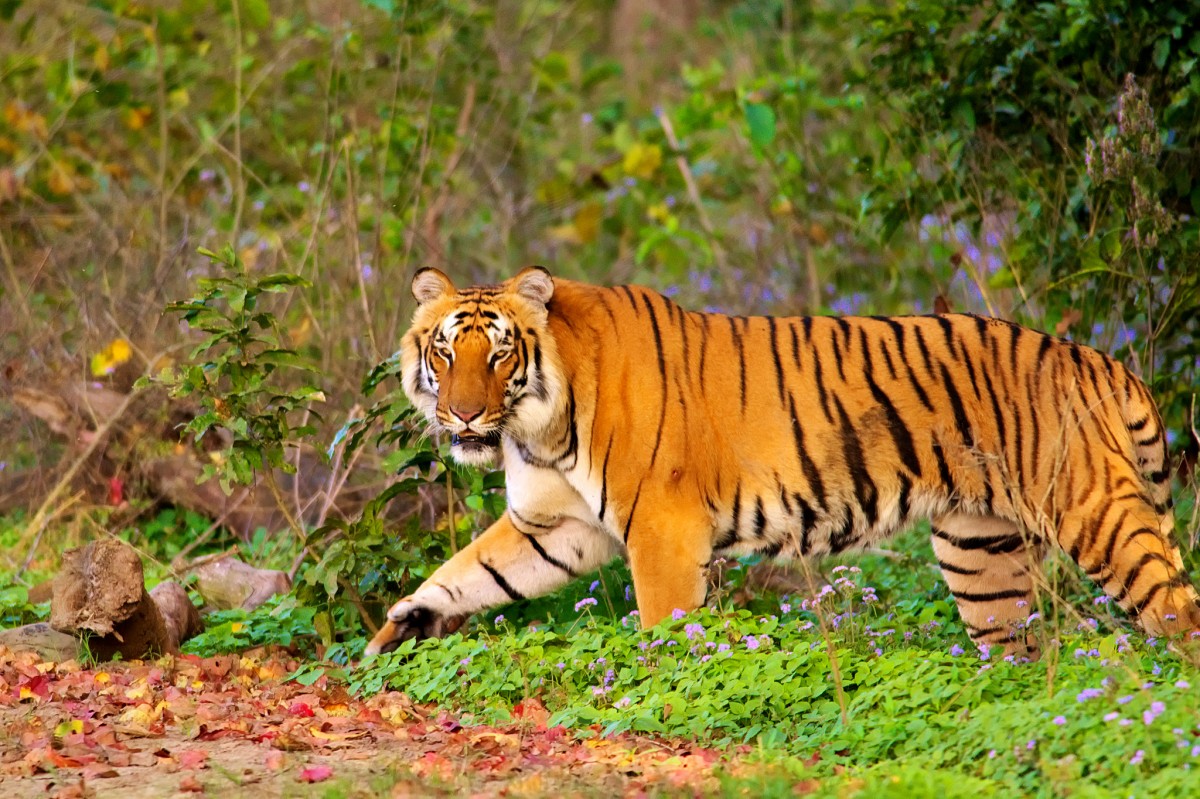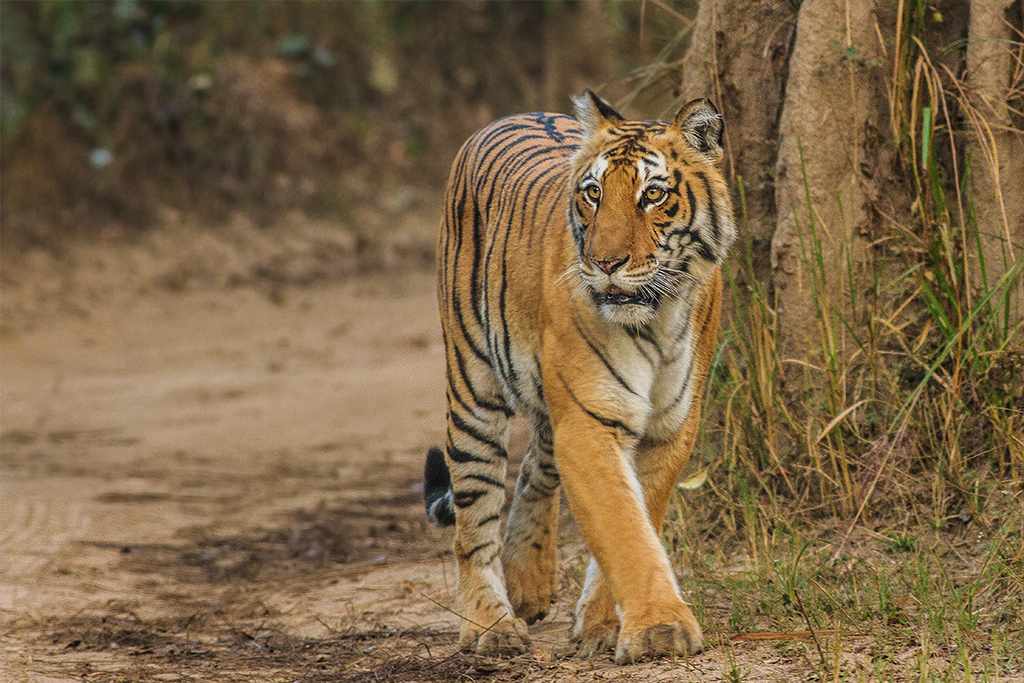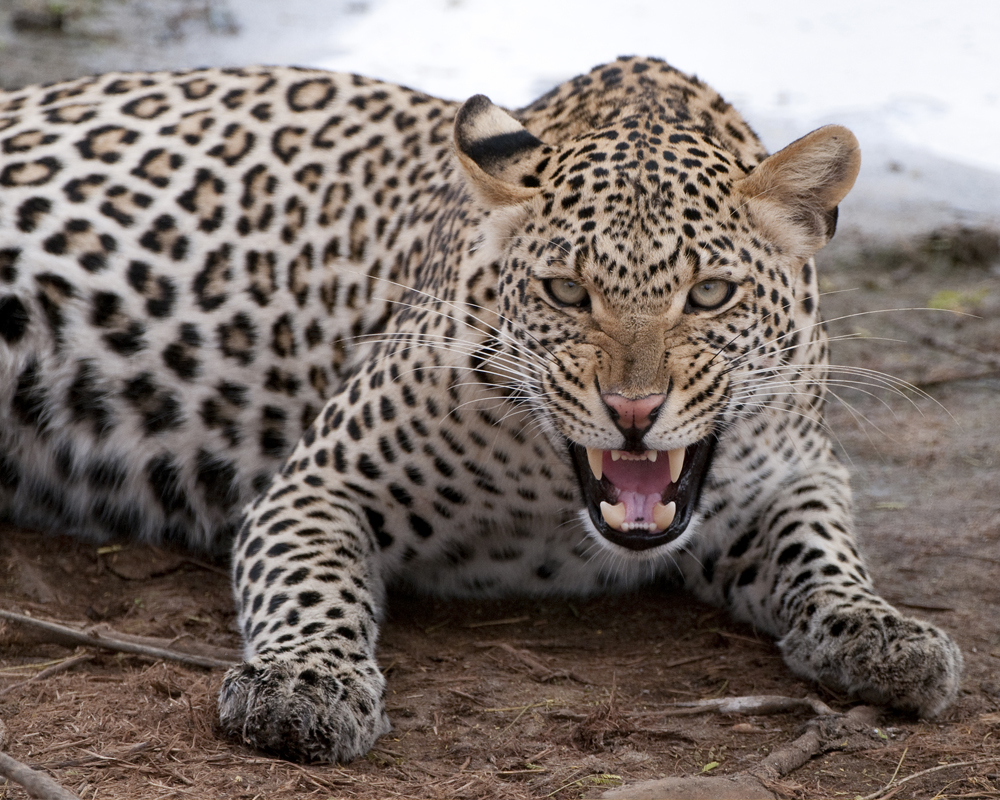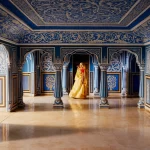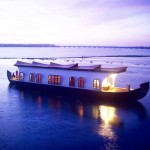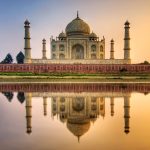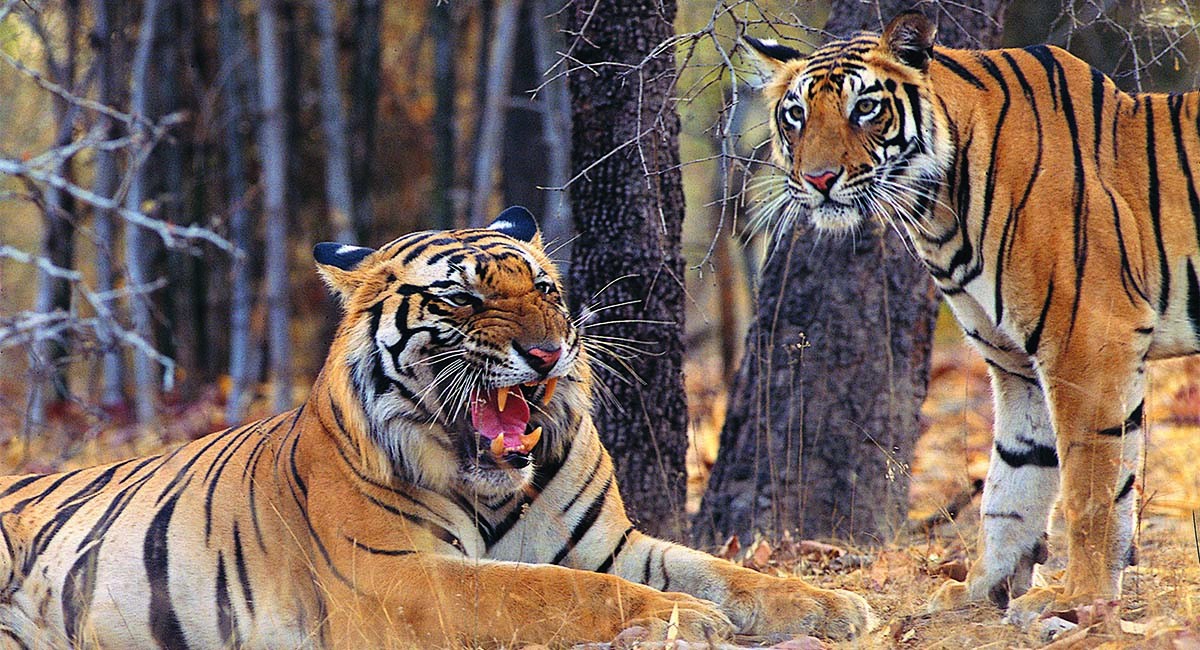
Bandhavgarh National Park
Park At A Glance
| IUCN Category | II (National Park) |
| State | Madhya Pradesh. |
| District | Umaria & Jabalpur. |
| Area | 450 Sq. Km. |
| Established On | 11.5.1982 |
| Special Status | Along with Kanha Home of White Tigers. Highest Tiger Density. |
| Area | 280 sq. kms./1161.471 sq. km. Buffer 536.719 sq. k. m |
| Altitude | 400 to 810 metres. |
| Biogeographically Province | 4.8.4 (Indus Ganges Monsoon Forest) |
| Geographical Location | About 130 km north-east of Jabalpur. Some 30 km, beyond Umaria. |
| Longitude | 23 degree 36’-23 degree 42’N |
| Longitude | 80 degree 7’-81 degree 06’E |
| Land Status | Government |
| Flora (Plants) | Sal, Bamboo. |
Physical Features: The landscape is a similar mixture of fairly steep and rocky hills, often with flat tops and with fairly level grassland or meadows in the valleys below.
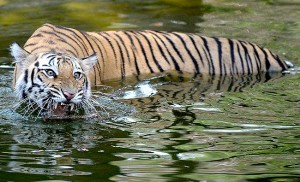
Commonly seen wildlife
Mammals: Nilgai, barking deer, rhesus macaque, black-faced langur, jungle cat hyena and porcupines.
Birds: Steppe eagle, blue bearded laceeater, white-bellied drongo Tickell’s blue flycatcher, white browed fantail flycatcher.
Rarely Seen
Mammals: leopard, jackal, fox, wild dog.
Birds: Malabar Hornbiil.
Vegetation Semi-evergreen Sal forest mixed with Terminalia, Anogeissus and bamboo species. Fauna (Animals): Tiger panthera tigris, leopard P. pardus, Indian wild dog Cuon alpines, jungle cat Felis chaus, sloth bear
Vanue for the Tiger Shows. Tigers are adapted to human presence
Melursus ursinus, civet, chital Axis axis, sambar Cervus unicolor, gaur Bos gaurus, chinkara (mountain gazelle) Gazella gazelle four-horned antelope tetiacerus quadricornis chevrotain Tragulus meminna, nilgai Boselaphus tragocamelus, muntjac Muntiacus muntjak, wild pig (boar) Sus scrofa and others. (The white tiger is an extremely rare species here).
Constraints: Bandhavgarh Fort in the centre of the park is still the private property of the former Maharaja of Rewa.
Seasons
Monsoon Mid-June to September Winter November to mid-February Summer Mid-March to mid-June
| Climate (deg C) | Summer-Max 41.4, Min 26; Winter-Max 21.1, |
| Rainfall | 1174 mms. |
| Best Season | March to June. The park is closed from July to Mid November. |
| Topography | Undulating terrain with hills, ridges, streams. |
| Nearest Town | Umaria (35 km). |
| Nearest Railway Station | Umaria (35 km), Satna (112 Km). |
| Nearest Airport | khajuraho(210 Km), Jabalpur (195 Km). |
Accommodation
White Tiger Forest Lodge (MPTDC), Forest Rest House (AC/Non AC), Jungle Comps and the
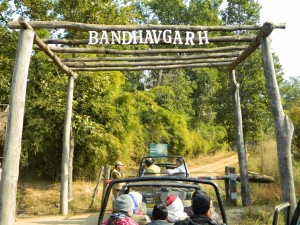
PWD Rest House are the available means of accommodation.
Tourist Information Centers
The Manager, Madhya Pradesh State Tourism Development Corporation Ltd., White Tiger Forest Lodge, Bandhavgarh, M.P.
The Divisional Forest Officer, Divisional Tourist Office, Bandhavgarh N. Park, Umaria M.P.
Period for Visit:
The ideal time to visit Bandhavgarh is the November to June Period. The park is closed from 1st July to 31st October, due to the monsoon, and the breeding season. Best Period: February to June, although the cool season is much more comfortable and still very good for wildlife. The park is closed from July 1 to October 31 because of the monsoon.
Clothing: Cottons, but carry woolens as well, as early mornings and evenings can be chilly, especially in a moving jeep and in the cold season. Avoid loud colours.
Arrival Bandhavgarh
Air: khajuraho (230 kms) is the most convenient airport connected by Indian Airlines flights with Agra, Delhi, Varanasi. Rail: the nearest railhead Umaria (30 kms) is on the Katni-Bilaspur section of South-Eastern Railway. Another convenient railhead Satna (117 kms) is on the Bombay-Howrah main line of the central Railway.
Road: Bandhavgarh National Park is situated on the Satna-Umaria & Rewa Umaria & highway. Some of the important road distances are: khajuraho (via Satna) 230kms, Rewa 115 kms, Umaria 30 kms, Kanha 250 kms etc.
Bus: S.T. Bus Services are available from Rewa, Stna Katni and Umaria.
Bandhavgarh National Park is small and compact, yet full of game. The density of the Tiger population here is the highest known in India. It lies in the heart of the Vindhyan Mountain Range in central India. Besides its enchanting landscape formed by the Sal forest in the valleys and majestic tree clad hills in the back-drop. It is famous for a wide variety of wild-life and archaeological remains of the kalchuri period. The park area is hilly and is dominated by the majestic Bandhavgarh fort, built in 14th century. The fort and the adjacent gills have a large number of caves belonging to the pre-historic period.
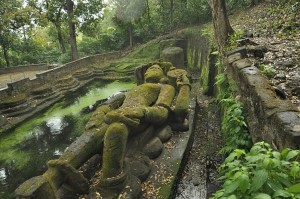
This is also White Tiger Country. These have been found in the old state of Rewa for many years. The last known was captured by Maharajah Martand Singh in 1951 (This White Tiger, Mohun, is now stuffed and on display in the palace of the Maharajah of Rewa).
The most convenient route to Bandhavgrh is by air to khajuraho from where it is a five-hour drive (237 km).
The terrain is of great rocky hills rising sharply from the swampy and densely forested valley bottoms. The finest of these hills is Bandhavgarh, sided with great cliffs and eroded rocks, and on its highest point stands Bandhavgarh fort, thought to be some 2,000 years old. Scattered throughout the park, and particularly around the fort, are numerous caves containing shrines and ancient Sanskrit inscription
In 1947, Rewa State was merged with Madhya Pradesh; Bandhavgarh came under the regulation of Madhya Pradesh. The Maharajah of Rewa still retained the hunting rights of Bandhavgarh and no special conservation measures were taken until 1968, when the areas were constituted as a National Park as an unspoiled natural habitat.
Covering 448 sq km, Bandhavgarh is situated in Shahdol district among the outlying hills of the Vindhya range. At the centre of the park is Bandhavgarh hill, rising 811 mt. Surrounding it are a large number of smaller hills separated by gently sloping valleys. These valleys end in small, swampy meadows, locally known as ‘Bohera’. The lowest point in the park is at Tala (440 mt). The vegetation is chiefly of Sal forest in the valleys and on the lower slopes, gradually changing to mixed deciduous forest on the hills and in the hotter, drier areas of the park in the south and west. Bamboo is found Throughout.
The forest of Bandhavgarh can be classified as moist deciduous and the National Park holds all those animal species which are typical of this habitat in Central India. The park is rich in wildlife. Certain areas of the park (particularly the south and the west) are drier in character, and hold such species as the Nilgai (Blue bull) and the Chinkara (Gazzle). Sal forest occurs throughout the valleys, giving way to mixed forest. Grassy meadow patches occur in the valley and along the nalas.
Chinkara, chausinga, wild pig are in abundance in the park. Are visible in March/ April.
Chitals arein thousands, Sambar muntjac are seen in thick vegetation area. While driving within the park one may also encounter rhesus macaque Jungle cats, hyaenas, porcupine, ratels.
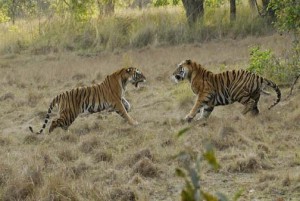
Wildlife in Bandhavgarh is densely populated with tiger and other wildlife species. The great Gaur (Indian Bison), can be seen with ease, as they come onto the meadows to graze at dusk; sambar and barking deer are a common sight and Nilgai are to seen in the more open areas of the park. There are more than 22 species of mammals and 250 species of birds. Common Langurs and rhesus macaque represent the primate group. Carnivores include the Asiatic Jackal Bengal fox sloth bear ratel gray mongoose striped hyena jungle cat leopard and tiger. The artipdactyls represented here & frequently sighted are wild pigs, spotted deer, sambar, Chausingha, nilgai Chinkara and Gaur: Mammals such as dhole the small Indian civet palm squirrel and lesser bandicoot rat are seen occasionally. Among the herbivores, gaur is the only coarse feeder. A rich bird population, (white browed fantail, steppe eagle, green pigeons Malabar hornbills, blossom headed parakeets, parakeets, blue bearded bee eater, white bellied grongo, jerfon’s leaf birds, white browned fantail) is an added attraction here.
The vegetation along streams and marshes is rich in bird life. The common ones are Little grebe, egret, lesser Adjutant sarus vrane Black ibis lesser whistling teal white-eyed buzzard, black kite crested serpent eagle black vulture Egyptian vulture common peafowl ted jungle fowl dove parakeets kingfishers and Indian Rollers. Reptilian fauna include cobra krait viper rat-snake python turtle and a number of lizard varieties including varanus.
There are two main ways of getting about in the park-in a motor vehicle or on elephant back. Jeep safaris are best undertaken from dawn until about 10am and from about 4pm until dusk, as the animals are most active during these periods. A Forest Department guide must always accompany you. This guide will be able to direct you and point out wildlife. Elephants are used every morning by the forest department for Tiger-tracking. If a tiger is found then the elephant will take you directly to the tiger either from the lodge or from a nearby point reached by jeep car (better to remain in contact of Park Authorities about it).
The tigers once roamed freely here but due to extensive hunting (Maharaja Venkat Raman Singh shot 111 tigers by 1914), their population came down drastically. Numerous steps were taken to conserve the wildlife here without spoiling the natural beauty of the park. Even today the Bandhavgarh National Park has retained its unspoilt look.
The Bandhavgarh National Park is the place where the famous white tigers of Rewa were discovered. The last known capture of the white tiger was in 1951 (‘Mohun’ is now stuffed and on display in the palace of the Maharaja of Rewa). Bandhavgarh is densely populated with other animal species too. The great gaur, Indian bisons can be easily spotted when they come to graze on the meadows at dusk. The sambar barking deer and nilgai are also common sights in the open areas of the park. The ancient fort of Bandhavgarh adds grace to the park. Climb the fort to get a bird’s eye view of the park. Do not miss the small population of naughty black bucks that live here, protected from the predators below.
Truly the most fascinating and most popular excursion from the national park is to the Bandhavgarh fort, located at the height of 800m., belonging to Royals of Rewa. This fort is in ruins now but the strong high walls of the fort tell a saga of valour and splendour. The fort blends with the wilds of the park and has become a part of the park. No one knows when the fort was constructed but scripts as old as Shiv purana have mention the fort is recommended (permission is granted locally) which can be accessed by foot or by jeep. The panoramic view of the wildlife reserve and surrounding courtside from the fort is a lifetime experience. According to the Indian epic Ramayana this ancient fort was built by the same monkey architect who erected the bridge used by Rama & Hanuman to invade Lanka.
The park in itself is historically very important. The signs of early habitation can be seen in the caves excavated from the cliffs to the north of the fort. Brahmi inscriptions here date back to the lst ccntury BC.
The park can be entered on elephant back and or in a jeep or by car. In these safaris a forest department guide always accompanies you. Hi will direct and tell about the flora and fauna of the park. The best time to visit the park is early in the morning or after 4 p.m. it is during this time that the animals are most active and are easily spotted
There are three well defined seasons-the cool (from middle of October to end of February), the hot (from middle of March to middle of June) and the wet (from middle of June to middle of October). The annual rainfall is 1.173 mm, coming mostly in the rainy season. The temperature ranges from a maximum of 42 D Celsius in may and June, to around 4 D Celsius in winter
Accommodation at Bandhavgarh: The forest department and the PWD have arranged good accommodation facilities here. The White tiger Forest Lodge is maintained by the Madhya Pradesh Tourist department. The forest department’s rest house and the PWD rest house are sufficient to fulfill the needs of the visitors. For reservations contact the Madhya Pradesh tourist offices. Ask for the Bandhavgarh Jungle Camp from the forest officials or the reservation authorities.
The Bandhavgarh National Park came into existence in the year 1968 with an area of 106 sq. km. and subsequently was extended with two adjoining forest areas covered with rich sal forest. forest. The central area of the park (100 Sq. km.) is the principal wildlife rich area.
It is a premier wildlife preserve in central India containing wide variety of habitats and wildlife including Tigers. The park has hills inside it and the sal forest is prominent here. The park remains closed during breeding season (July-October). It is well approachable from Umaria & Satna having railway stations.
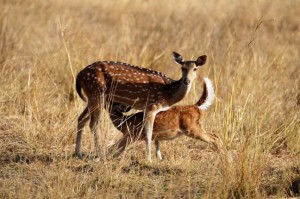
Bandhavgarh also has a place in Indian mythology and epics as Rama the hero of Ramayana stopped at this place after defeating demon king Rawna of Lanka, it is also said the architect of Bandhavgarh fort are the monkeys who built the bridge (Setu) between the mainland and Srilanka. Maharaja of Rawa is know as Bandhavdhish (the lord of forest)-Lakshaman the brother of Rama is the idol of the temple here. It was the ancestral state of royals of Rewa, but due to loss of royal patronage it remained neglected for a long time and was an active hunting reserve. In the year 1968 while it came into existence as a National Park it helped in controlling poaching which helped in all round prospering of wildlife (tigers in particular). The territory of this park was extended in the year 1986.
Despite its claim to have the highest density of tigers of any reserve in India it could not enjoy the popularity of Kanha, it is 195 km north west of Jabalpur and packs the same wealth of wildlife in a smaller area and offers fine scenery and exotic ancient ruines. Bandhavgarh tigers have international standing. The park is recommended to visit during summer months as visibility of games goes up, one can see tigers with support of forest authorities within the park who arrange for elephants and other required things for the early morning safari. One can hire jeep and guides with walkie-talkies (with forest guard) outside the park. It is advisable that these arrangements are kept well informed about tiger availability and take visitors to their vicinity. The park roads are good for Jeep drives and can be hired from few non-government operators working in the park area.
Most of the park area is covered with rich sal forest although at high altitude mixed forest is comprises Sali, saj saja etc., large also distributed. The park has number of streams one of them is charganaga, with its source near fort. While making a trip to the fort one can see statues &temples and 10th century rock statue of lord Vishnu, unspoiled and unexploited till date. The crag martins and limited blackbuck population is seen in fort surroundings.
Thus Bandhavgarh has a competitive edge over other parks for its game and birds and is well approachable from khajuraho and other places. The temperature of Bandhavgarh varies with the season while it remains between 0oC 20oC (November-February) in winters, it goes up to 40o C in summer. The breeding season (monsoon season) of July-November is off season and the park remains closed during this period.
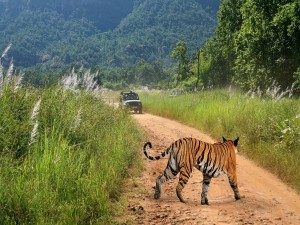
Although it is much harder to reach Bandhavgarh with public transport and budget travelers find it difficult, yet one’s determination to see a wild tiger may overcome everything costs nothing if one gets to see a majestic tiger in its natural surrounding. Thus a trip to Bandhavgarh is worth considering. The park is open from November to June and the best time to visit is during the cool month of December to March. It is better if one has one’s own vehicle, as reaching here is bit tricky. Jabalpur is the place from where one has to catch the train up to Katni, and opt for South Eastern Railway’s service to Umeria, the nearest railhead to park. Regular buses leave for Tala, 35 km, northeast. The nearest airports are Varanasi and khajuraho and one can reach here via Satana and Katni. For visitors from Delhi, Utkal Express leaving from Nizamuddin Railway station is best as it is nearly a 19 hrs. journey. Limited Jeeps are available with some hotels at Bandhavgarh and are only means of transport around the park. The charges are based on the kms covered and get divided among the people in the group. Elephant Safaris are discontinued but it is still possible to enjoy a quick jaunt on elephant back.

